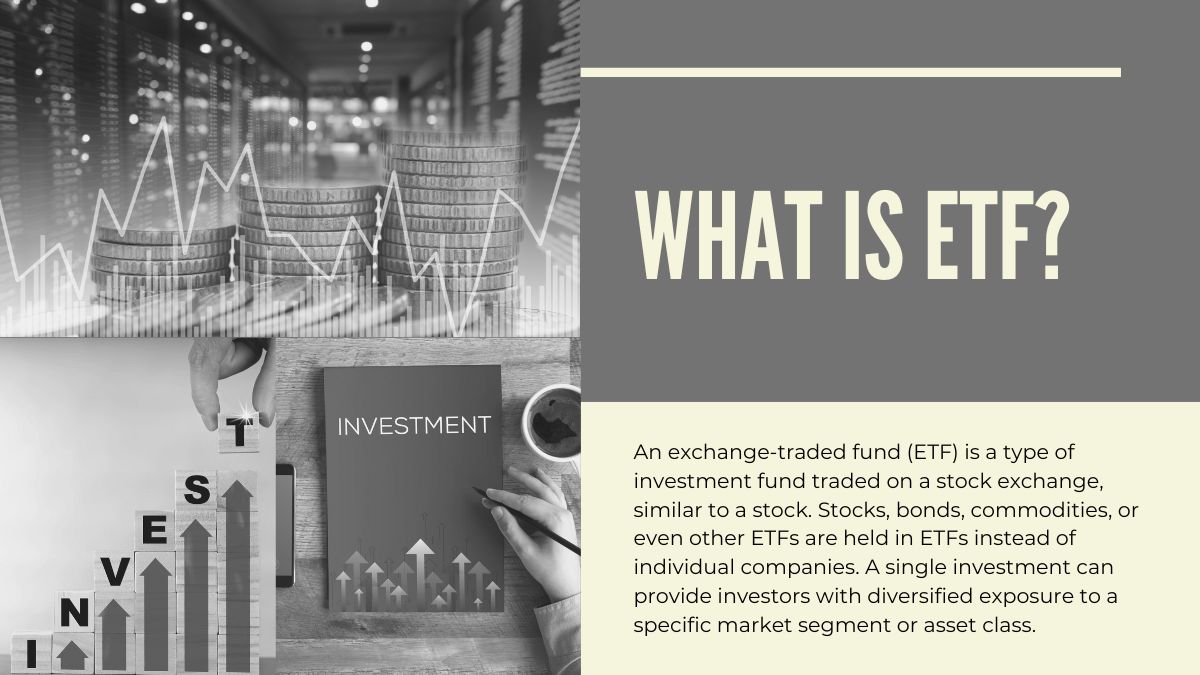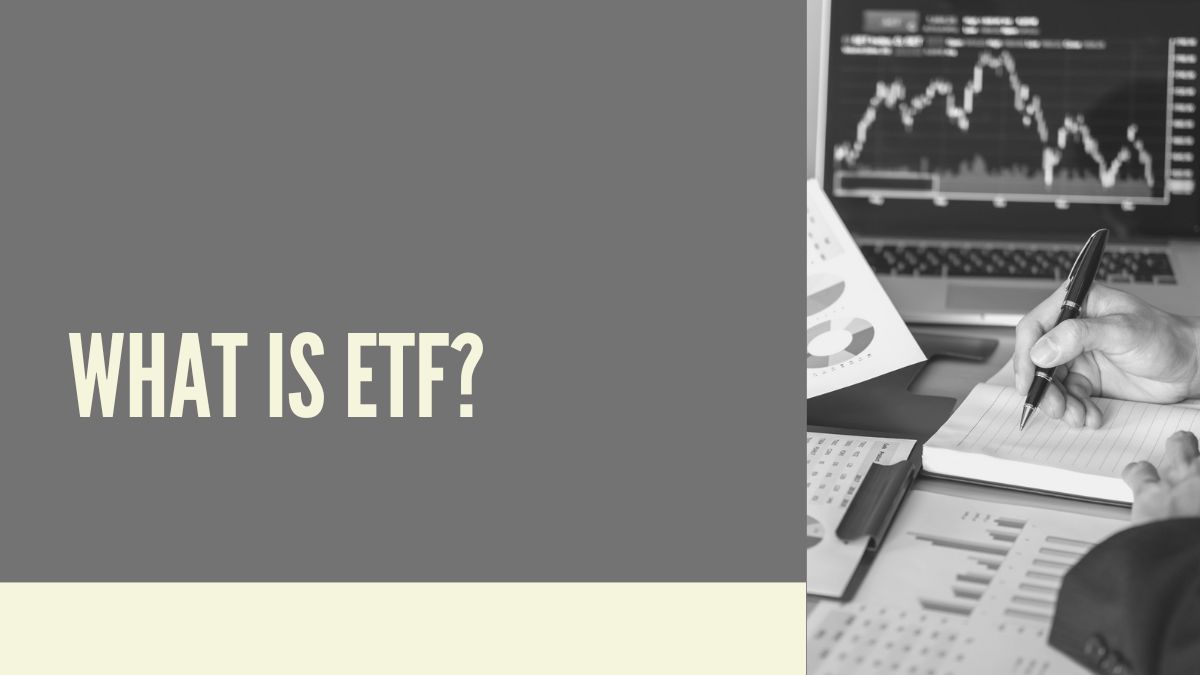Today, Exchange-Traded Funds (ETFs) are becoming an increasingly popular and versatile investment tool. Investments in ETFs, unlike traditional mutual funds, are traded on stock exchanges like individual stocks. They provide investors with diversified exposure to a wide range of assets, such as stocks, bonds, commodities, and even real estate.
What is ETF?

An exchange-traded fund (ETF) is a type of investment fund traded on a stock exchange, similar to a stock. Stocks, bonds, commodities, or even other ETFs are held in ETFs instead of individual companies. A single investment can provide investors with diversified exposure to a specific market segment or asset class.
In other words, ETFs are instruments designed to replicate the performance of underlying indices, benchmarks, or assets.
Types of ETFs
ETFs encompass a wide range of asset classes, offering investors diverse investment options. Here are some of the main types:
- Equity ETFs: These track stock market indexes, sectors, or specific investment types (for example, growth and value). Examples include ETFs that track the Nifty 50, Sensex, or specific industry sectors such as technology or healthcare.
- Bond ETFs: These invest in a variety of bonds, including government, corporate, and municipal bonds. They provide exposure to fixed-income markets and can help diversify a portfolio.
- Commodity ETFs: These track the prices of commodities such as gold, oil, and agricultural items. They can be used to protect against inflation or acquire access to natural resources.
- Currency ETFs: These monitor the exchange rates between various currencies. They can be used to protect against currency volatility or to speculate on future moves.
- Real Estate ETFs: These invest in real estate assets like real estate investment trusts (REITs) and mortgage-backed securities. They provide exposure to the real estate market without direct property ownership.
- Specialty ETFs: This category includes a diverse range of niche ETFs, such as those focused on certain themes (e.g., clean energy, artificial intelligence), investing techniques (e.g., leveraged ETFs, inverse ETFs), or geographical locations.
How Do ETFs Work?
Investing in ETFs involves tracking a specific index or asset and replicating its performance. In order to achieve this, a portfolio of assets is maintained that mirrors the composition of the underlying index.
Investors can buy and sell shares throughout the trading day with ETFs traded on stock exchanges. Compared to traditional mutual funds, which tend to trade at the end of each day, the liquidity of these funds is key.
The price of an ETF is influenced by several factors, including the performance of the underlying assets, supply and demand for the ETF shares, and market sentiment. In the same way that stocks fluctuate throughout the day, ETF prices can do the same.
How to Invest in ETFs?
Investing in ETFs generally involves a few key steps:
- Research and Selection: Begin by identifying ETFs that meet your investment objectives, risk tolerance, and time horizon. Consider the ETF’s underlying assets, expense ratio, and trading volume.
- Open a Brokerage Account: To purchase or sell ETFs, you’ll need a brokerage account. Many online brokers provide a choice of ETFs and trading platforms.
- Fund Your Account: Deposit funds in your brokerage account to pay the cost of the ETFs you want to buy.
- Place an Order: Use your brokerage platform to place an order for the desired ETF. You normally have the option of placing a market order (buying or selling at the current market price) or a limit order (specifying a precise price at which you are willing to buy or sell).
- Monitor Your Investments: Regularly analyze the performance of your ETF investments and make any necessary modifications.
Advantage and Disadvantage of ETF
Advantages of ETF:
| Advantage | Description |
|---|---|
| Low Costs | Generally have lower expense ratios compared to actively managed mutual funds. |
| Diversification | Offer instant diversification by investing in a basket of assets. |
| Liquidity | Trade on stock exchanges throughout the trading day, providing flexibility for investors. |
| Tax Efficiency | Can offer tax advantages, such as lower capital gains taxes. |
| Transparency | Holdings of ETFs are typically transparent and easily accessible. |
| Wide Range of Options | Available for various asset classes, sectors, and investment strategies. |
Disadvantages of ETF:
| Disadvantage | Description |
|---|---|
| Market Risk | Subject to market fluctuations, meaning their value can decline. |
| Tracking Error | Some ETFs may not perfectly track their underlying index. |
| Counterparty Risk | In some cases, investors may face counterparty risk with certain types of ETFs. |
| Trading Costs | Brokerage commissions and other trading costs can impact returns. |
| Intraday Price Fluctuations | Prices can deviate from the underlying asset value during periods of high volatility. |
How Do ETFs and Mutual Funds Compare?
There are key differences between ETFs and mutual funds, but both are popular investment options. ETFs are like stocks because they trade during the day on stock exchanges and follow a specific index via passive management. In general, this results in lower expense ratios than actively managed funds.
Net asset value (NAV) is used to price and trade mutual funds at the end of the day. It is possible for them to be actively managed, in which fund managers make investment decisions in an effort to outperform the market. In addition to offering diversification benefits, ETFs can provide more liquidity and be more tax-efficient. Investing goals, risk tolerance, and trading preferences all play a role in deciding between ETFs and mutual funds.
Is India ETF a Good Investment?
Investing in Indian ETFs depends on the individual’s financial goals, risk tolerance, and investment horizon. Their potential advantages, however, include:
- Diversification: Indian ETFs can provide exposure to a wide number of sectors and firms in the Indian market, allowing investors to diversify their portfolios while reducing risk.
- Low Costs: Many Indian ETFs have low expense ratios, making them a budget-friendly investment alternative.
- Liquidity: ETFs trade on stock exchanges, providing investors with liquidity and the ability to purchase and sell shares throughout the trading day.
- Transparency: The majority of ETFs have transparent holdings that make it simple for investors to understand the underlying assets.
- Accessibility: Many different types of investors can access Indian ETFs because they are easily accessible through the majority of brokerage platforms.
However, it’s important to consider possible drawbacks:
- Market Risk: The value of Indian ETFs may decrease due to market movements.
- Tracking Error: It’s possible that some ETFs don’t exactly mirror their underlying index.
- Counterparty Risk: Certain ETF types may occasionally expose investors to counterparty risk.
Is ETF Taxable in India?
Yes, ETFs in India are taxed. ETFs are taxed differently depending on their type and holding period
What is ETF in Crypto?
Investing in cryptocurrency ETFs, or Exchange-Traded Funds, is like investing in stock market indexes. This allows investors to gain exposure to the crypto market without directly purchasing and holding cryptocurrencies. A cryptocurrency ETF typically invests in a basket of cryptocurrencies or derivatives tied to them, such as futures contracts.
When compared with investing in one cryptocurrency, diversification can help mitigate risk. A crypto exchange-traded fund (ETF) makes it possible for investors to buy and sell crypto assets throughout the trading day, just like a traditional ETF on a stock exchange. Investors have become increasingly interested in cryptocurrencies because they are a relatively new investment vehicle.
Do ETFs Provide Diversity?
It is true that ETFs are a powerful tool for diversifying an investment portfolio. The reasons are as follows:
- Instant Diversification: Investing in a single exchange-traded fund (ETF) exposes you to a variety of assets, including stocks, bonds, and commodities. This immediate diversification aids in distributing risk among several industries and asset types.
- Wide Range of Options: Investors can create diversified portfolios that are suited to their individual objectives and risk tolerance thanks to the availability of exchange-traded funds (ETFs) covering a range of asset classes, industries, and investment strategies.
- Cost-Effective Diversification: ETFs are a cost-effective method of achieving diversity because they frequently have lower expense ratios than actively managed funds.
You may be able to lower overall risk and raise your chances of long-term investment success by adding a range of ETFs to your portfolio.

